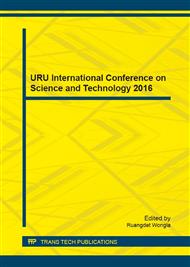p.75
p.82
p.91
p.98
p.103
p.108
p.114
p.121
p.126
Biogas Production from Anaerobic Co-Digestion of Food Waste Mixed with Domestic Wastewater
Abstract:
This research was to investigate the potential of biogas production from the co- digestion of canteen wastewater and food waste. Batch experiments were carried out under various substrate ratios1 : 1 : 0, 1 : 1 : 1, 1 : 1 : 2, 1 : 2 : 1, 2 : 1 : 1, 2 : 2 : 1, 3 : 2 : 1, 4 : 2 : 1, 6 : 5 : 1, 8 : 5 : 1, 10 : 3 : 1, 10 : 4 : 1 and 10 : 5 : 1 (canteen wastewater : swine manure : food residue waste) at room temperature. The biogas production was carried for a retention period of 7 days to investigate suitable mixing ratio. The suitable ratio was tested in a plastic container 200 liter with bath and fed-batch experiment for a retention period of 45 days. The results revealed that fermentation slurry mixing ratio of 1 : 2 : 1 was found to be optimum, which gave the methane production with composition 47.34-61 %CH4. The biogas yield and thermal energy were 88.86 L/day and 69 kcal respectively.These primary results indicated the significance of co-digestion of canteen wastewater with food waste for biodegradation and biogas production.
Info:
Periodical:
Pages:
103-107
Citation:
Online since:
October 2016
Authors:
Keywords:
Permissions:
Share:
Citation:


